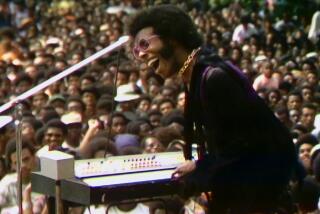So Far, This Revival Has a Case of the Blues
- Share via
Shuggie Otis has frequently been likened to Sly Stone musically, but Otis on Thursday revealed another, less admirable similarity to the leader of Sly & the Family Stone, who made an art of the no-show.
With the pieces in place for an escalation of his unlikely career revival, Otis, 47, nearly sabotaged this closely watched event, arriving at the El Rey Theatre just minutes before his scheduled 10 p.m. show time--still, much to the relief of the worried record label personnel, booking agents and concert promoters who hadn’t heard from him for nearly 24 hours as he drove to L.A. from his Northern California home.
That close call illustrates the kind of unpredictability--including his recent cancellation of scheduled interviews with some major publications--that’s marked Otis’ return to the spotlight. And it’s as good an indication as any of why he disappeared from the pop music radar after his 1974 masterpiece “Inspiration Information” met with commercial failure.
In the early ‘70s, the only question appeared to be which path to stardom the young musician would take. The teenage prodigy brought a searing guitar style to the shows and records of his father, L.A. R&B; pioneer Johnny Otis. He played with Frank Zappa, teamed with musician-producer Al Kooper on a 1969 album for Columbia, made three albums for Epic and even, legend has it, turned down an offer to replace Mick Taylor in the Rolling Stones.
The last of the three records, “Inspiration Information” was his “Pet Sounds,” an idiosyncratic, evocative product of three years spent alone in his home studio in Los Angeles. In various ways, it extended the traditions of Stevie Wonder, Sly & the Family Stone and Marvin Gaye, with winsome touches of psychedelia and a personal vision that anticipated Prince.
The collection’s languid grooves form a bridge to such current revivalists as D’Angelo, and while Otis’ heavy use of the drum machine sounded strange at the time, it makes the record sound surprisingly contemporary in 2001.
Which might explain why its March reissue on David Byrne’s Luaka Bop label sparked more than routine interest and brought Otis out of his retirement--a period of infrequent dabbling in music.
The image of the lost soul genius was hard to resist, and Otis got notice not just in rock magazines but also in the New Yorker. He appeared on David Letterman’s and Conan O’Brien’s shows, and he played a high-profile Manhattan showcase.
The re-release has sold more than 40,000 copies, and his hometown shows at the El Rey on Thursday and Friday--the start of a brief road-test tour--formed a symbolic portal for Otis’ return to active duty. But with an eager audience dominated by young, indie-rock types waiting for a stirring resurrection, Otis delivered what amounted to a public rehearsal.
Imagine a vanished Brian Wilson surfacing to celebrate a rediscovered “Pet Sounds” and playing a show of Chuck Berry tunes. That’s essentially what Otis did, loading his set with familiar, generic blues workouts and a Hendrix tune while offering only one new song and a couple of “Inspiration Information” selections.
*
“He’s very excited about what’s going on, and last night he was extremely excited and extremely nervous,” Jeff Kaye, director of marketing and public relations for Luaka Bop, said Friday. “He’s been out of the public eye for 25 years and is still pretty unsure about how to represent himself to people.”
That’s how it appeared as Otis fidgeted with his amps and cords and repeatedly stalled the show to tune his guitar. He also struggled to keep his six-piece band (including his brother Nicky on drums) together and at one point taught them the chords to a song. Otis clearly wasn’t prepared for the moment.
By the time he ended the evening with “Strawberry Letter 23,” a song from his 1971 album “Freedom Flight” that became a hit for the Brothers Johnson in 1977, Otis’ audience had dwindled to a fraction of its original size.
Otis’ Santana-esque guitar virtuosity kept things afloat, but until he finds a focus and determination to match his chops, his heart will remain in 1974.
“It’s interesting to see if he’s up to the challenge of making a comeback,” said Luaka Bop’s Kaye. “He’s made 100% progress already, and he has another 100% to go.”
More to Read
The biggest entertainment stories
Get our big stories about Hollywood, film, television, music, arts, culture and more right in your inbox as soon as they publish.
You may occasionally receive promotional content from the Los Angeles Times.










